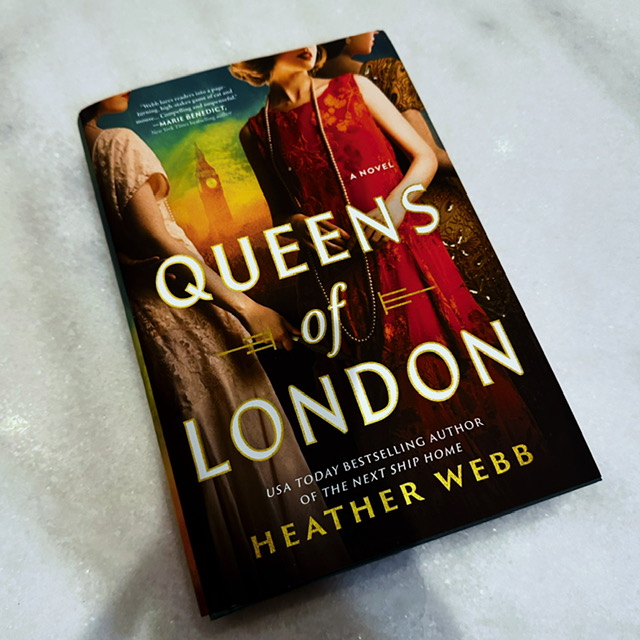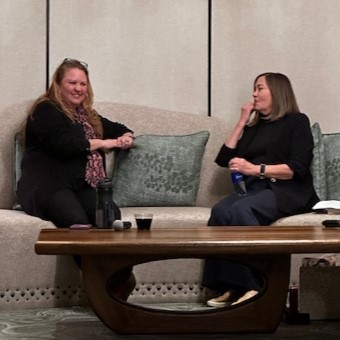
Earlier this month, I found myself back at the Atlanta History Center to hear Heather Webb discuss her latest release Queens of London. The book, based on a true story from London just after World War I, falls into Webb’s wheelhouse of 1920’s historical fiction and follows a line of great books from this author. I was impressed by both Webb’s ability to connect with the story and with the audience at the event – her experience as a high school teacher in her stage presence and her writing as she educates the audience and makes history come alive!
If you would like to avoid spoilers or too much detail, please skip ahead by clicking here.
This story is based on the Forty Elephants crime syndicate – an all-female crew of shoplifters and thieves in London. This famous group of women tackled challenges of the post-war London as well as women’s issues of the 20th century. Webb’s main character is Diamond Annie, the most infamous criminal in London history. She decided she wanted the beautiful things the middle and high class society women had, but didn’t have the means to obtain. Her moral compass was compromised so badly she had no second thoughts about using crime to get what she wanted.
Webb’s second main character (there are 4) is one of the most famous female Scottland Yard detective – Lilian Wyles. Wyles was part of the original female workforce at Scottland Yard which numbered around 100. After the war, their staff was cut to just 20, including Wyles, as the men came home to reclaim their occupations. Wyles knew that solving a big case was the only thing that could prevent the remaining 20 women from being cut as well. This struggle was not unique to the London law enforcement officers – women across Europe and America were losing their income as they were laid off to make way for the returning soldiers.
Webb’s two remaining main characters are fictional – a shopkeeper and a young girl. The shopkeeper faces other challenges women in the 1920’s saw – marginalized and called just a “pretty girl”, she wanted to become a designer in her own right, but couldn’t break into the men’s world. The young girl faces poverty and shows the challenges the lower class experienced during the depression. This child is also the moral compass of the story and for the other characters.
Webb discussed what life was like in 1920’s London compared to America. The main difference the author pointed out was how devestated the country was. London had a greater physical loss, as well as a greater loss of fighting men per capita. During the war, a greater percentage of the London workforce were women than in America. These women got a taste of freedom and purpose from working outside the home that they lost when their men came home. However, they also saw a greater rate of women unable to marry or have families because of a lack of men in the population.
Women in London also experienced a longer wait for the right to vote than those in America. For English residents, a woman’s right to vote came with stipulations until recently, which included their husband’s voter registration status among other things. Unmarried women or those who lost their husbands in the war faced an inability to vote based on these requirements. This second-class status and the struggle to provide for their families is what drove many of the Forty Elephants women to crime.
In discussing this book, Webb mentioned the difficulties that come with writing from four points of view. She chose to write in third person rather than first to give distance from the characters. This multi-person point of view, along with the dog that follows the main characters gives the book the feel of a Dickens novel as pointed out by the moderator.
Towards the end of the discussion, Webb was asked about her writing process. She said all books, either written by herself or with a partner, start with a plot synopsis and character sketch upfront. While the plot may change from this initial plan, this 4-6 page document drives the next steps, including the historical outline she completes to organize the facts that will inspire the storyline.
Webb worked on Queens of London for around two years, which she stated was her average timeframe for a solo project. The author normally has several projects going at any given time and finds taking time to work on something different often inspires another storyline. Webb also discussed what she calls “Death Valley” – the middle of the writing process that moves slowly for her. She has a list of questions that help her overcome any type of writer’s block. Webb also finds skipping ahead to another scene and then backfilling the difficult section helps to move the writing forward.
During the Q&A, Webb was asked about the coverart for this book and it’s beautiful colors. Webb revealed the publisher actually floats a few covers and titles to focus groups. Queens of London was not the original title, but she has come to love it. After the publisher chose the cover and title, Webb wove that title back through the book as well. Webb doesn’t make the final decision, but does have some say in these choices, but mentioned she has no input in the audiobook narrator.

When asked what this novel is really about, what she wants readers to take away, Webb stated she was fascinated by the idea of justice. We think of justice as a black and white concept, but there’s a gray area – it does not have rigid boundaries but flows because actions can be justified for the right reasons. The author also discussed the concept of women helping women that has been prevalent in many of her works. Near the finale of the event, Webb was asked about how she balances history and fiction in her writing. She mentioned that these topics set the framework for the storyline, but the fun is in tweaking the story. After much research and investigation, she gets to know these characters and any tweaks are meant to be in line with the characters’ known decisions and actions.
Webb’s next solo book will arrive in 2026. Tentatively titled “The Hope Thief”, this book is centered on a fictional jewelry who works for the last woman who owned the Hope Diamond. Set in 1919, this book will return back to the time period Webb enjoys the most.
Have you read Queens of London yet? Tell me your thoughts in the comments!
This post contains affiliate links.
What I’m Reading
- Current print book: Toxic Prey, John Sandford
- Current audio book: PS, I Love You, Cecelia Ahern
- Book I’m most looking forward to: Eat Pray Love, Elizabeth Gilbert
Discover more from Read With Lindsey
Subscribe to get the latest posts sent to your email.
